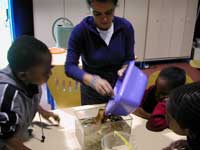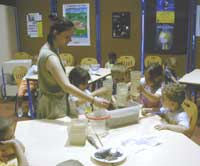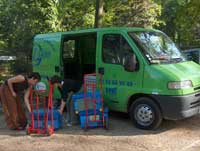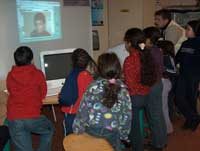Explor@mobile: using new technologies to teach science to teenagers Teach article
Claire Le Moine from Explor@dome in Paris, France, explains the formula of the explor@mobile: two scientists, some computers and a gas-powered vehicle!

Explor@dome
The Explor@domew1, a Paris science centre, is a popular place for science teachers to take a class of students eager to try things out for themselves – no ‘please do not touch’ signs, plenty of interactive activities, and staff willing to explain how to make a square wheel roll, demonstrate how to generate a tornado or assist in building an arched bridge.
But for many schools, a trip to the Explor@dome is simply too complicated and too expensive to organise. So with the help of Apple, who provided laptops, and Gaz de France, who donated a natural-gas-powered car to transport the equipment, Explor@dome decided to extend its activities into the surrounding primary and secondary schools. Its science and multimedia vehicle, the explor@mobile, took to the road in September 2002 and has never looked back.
For many students, science lessons still mean equations and diagrams, which – particularly for students with learning difficulties – can be hard to understand. On the other hand, science lessons consisting purely of practical work and experiments would be difficult to provide and would not allow students the chance to assimilate what they have learned. In the explor@mobile, multimedia activities offer an innovative alternative.

Explor@dome
Scientific concepts are introduced to students through two workshops, run by mediators from the Explor@dome. The first workshop focuses on practical scientific activities, such as building a ‘magic box’ to investigate symmetry (see box below), experiments on transformations of state in water, or pinhole photography. Phenomena such as forces or airflow are demonstrated using multimedia simulations.
The second workshop involves multimedia activities to reformulate and reinforce what was learned in the scientific workshop. Students may develop a slide-show presentation, or create a website, exhibition panels or a video film. The laptops brought in the explor@mobile allow the use of equipment and software (e.g. Photoshop or PowerPoint) not necessarily available in schools.
Examples of projects conducted in 2005-2006 with local secondary schools include:
- The production by 12-year-old pupils of a CD-ROM investigating the links between art and mathematics, covering optical illusions, paving and geometric constructions
- The creation of an illustrated novel and an exhibition on pinhole photography, by a class of 12-year-olds with learning difficulties. Photographs were taken using a pinhole camera made out of a tin can
- The design of exhibition posters about energy, by a class of 15-year-olds who intended to enter vocational training
- The production of a scientific documentary on a DVD by a class of 13-year-olds with learning difficulties.

Explor@dome
For these projects, the explor@mobile visited the schools to provide students with six scientific and six multimedia workshops, each lasting one-and-a-half to two hours. Other projects involved up to 20 sessions with a group of students. The workshops are free to schools and students, thanks to financial support from the local government (‘conseil general’) in charge of secondary schools, the PENCIL projectw2 and other sources of funding.
The interdisciplinary nature of many of the projects, involving not only science, but also written communication, oral communication and information technology skills, draws in students who are not typically interested in science. And not only the students – many of the activities have involved collaborations between teachers from several disciplines.
The use of multimedia activities has many advantages. The students not only are interested initially by the activities, but also remain interested and committed to the project. Much of the information used in the workshops is taken from the Internet, demonstrating to students that – provided they are sufficiently selective – this can be an invaluable source of scientific information and relevant images.

Explor@dome
As the students reformulate what they have learned to present it to others, whether as a website or an exhibition, they reinforce what they have learned and discovered, developing presentation skills in the process. Finally, the collaborative creation of a real and durable multimedia product demonstrates to the students the rewards and satisfaction of the project approach.
But the students are not the only ones to benefit. Teachers have also appreciated the originality of the presentations and the quality of the material provided, whereas the Explor@dome mediators enjoy the challenge of designing projects for a new audience.
A laboratory of cognitive psychology at the University of Nanterre, France, investigated the impact of explor@mobile workshops linking mathematical concepts (symmetries and proportions) to a multimedia activity involving digitally editing photographs (see box below). The results suggested that the explor@mobile workshops helped the children to apply the mathematical concepts that they learned to new situations. Children who had not worked with the explor@mobile had greater difficulties. In particular, giving presentations and doing multimedia activities increased the children’s ability to transfer their knowledge. Their degree of understanding of the topic was more closely linked to the context of the work. Further quantitative evaluation of explor@mobile is planned.
PENCIL
The explor@mobile is one of the activities in the PENCIL projectw2 (Permanent EuropeaN Resource Centre for Informal Learning). PENCIL, co-ordinated by Ecsitew3 and funded by the European Commission as part of the NUCLEUS clusterw4, aims to strengthen the operational relations between schools and informal science education in science centres and museums. Fourteen science centres and museums have developed pilot activities in partnership with teachers and schools; material is already available online. Academic and school partners are now working to identify key ways to transform informal science activities into innovative, high-quality tools for science teaching.
Symmetry activities
In the first, ‘scientific’ workshop, the students (ages 12-13) investigate bilateral symmetry by making geometric drawings, studying different geometric shapes and objects, and constructing a ‘magic box’ containing a mirror. They build half an object out of modelling clay and place it on a mirror, so that it appears whole and bilaterally symmetrical. Once the magic box is closed, the object appears to float and the mirror ‘disappears’. Investigations continue with the construction of a camera obscura.
In the second, ‘multimedia’ workshop, students use software to investigate different symmetries in pictures and produce kaleidoscopic images. In a further scientific workshop, they build a kaleidoscope.
Symmetry is part of the school curriculum for students of this age, and these activities provide new ways to address mathematical concepts and to apply what they have learned to real objects (cameras, magic boxes and the kaleidoscope). For teachers, it provides a method to test if the students have understood their lessons on symmetry and whether they can apply their knowledge to new situations.
Web References
- w1 – The Explor@dome website
- w2 – Information about PENCIL is available on the Xplora website
- w3 – The website of Ecsite, the European organisation representing science centres and museums
- w4 – Information about NUCLEUS is available on the Xplora website





